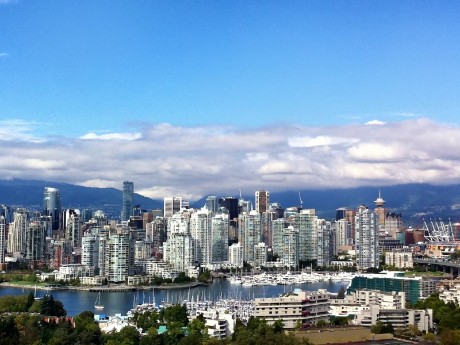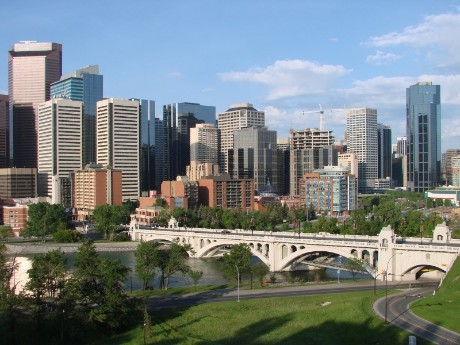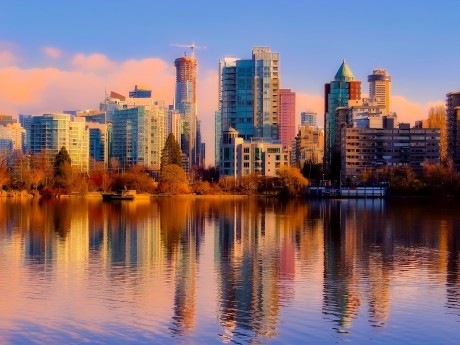Canada: Vancouver and Calgary
Embark on an unforgettable trip to Western Canada! Begin in Vancouver, the capital city of British Columbia, nestled between the Pacific Ocean and the Coastal Mountains. Explore Stanley Park, a lush urban oasis with walking and biking trails, and visit Capilano Suspension Bridge Park for thrilling treetop views. Then, head to Calgary, where the Calgary Tower offers breathtaking panoramic views of the city and the Rocky Mountains beyond.
Read more
Embark on an unforgettable trip to Western Canada! Begin in Vancouver, the capital city of British Columbia, nestled between the Pacific Ocean and the Coastal Mountains. Explore Stanley Park, a lush urban oasis with walking and biking trails, and visit Capilano Suspension Bridge Park for thrilling treetop views. Then, head to Calgary, where the Calgary Tower offers breathtaking panoramic views of the city and the Rocky Mountains beyond. Dive into local culture at the Glenbow Museum, which showcases fascinating exhibits on Western Canadian history and Indigenous art. Whether you're captivated by Vancouver’s natural beauty or Calgary’s rich heritage, this trip promises an exciting blend of experiences! Waterviews strives to offer accommodation options within walking distance of water and/or in an area of touristic interest. Our prices include taxes (but excludes local tourist taxes). Customize your trip to your personal preferences with optional activities (hit the “Add Activities’’) or change hotels, etc. Contact us for customization at no extra cost at: Service@waterviewstravel.com
Destinations
- Vancouver
- Calgary
Itinerary
Vancouver

A vibrant, progressive and scenic city, Vancouver is the third largest metropolitan area in Canada. Its ethnically diverse population and mixture of modernity and tradition results in a vibrant atmosphere and culture, boasting festivals, excellent food and a lively arts scene. The city was home to events such as the 2010 Winter Olympics and is also well-established in the film industry, often named as the 'Hollywood of the North'. Add to all of this the incredible nature right on its doorstep, and Vancouver makes for an excellent visit.
Read more
A vibrant, progressive and scenic city, Vancouver is the third largest metropolitan area in Canada. Its ethnically diverse population and mixture of modernity and tradition results in a vibrant atmosphere and culture, boasting festivals, excellent food and a lively arts scene. The city was home to events such as the 2010 Winter Olympics and is also well-established in the film industry, often named as the 'Hollywood of the North'. Add to all of this the incredible nature right on its doorstep, and Vancouver makes for an excellent visit.
Additional Information
While Vancouver is a comparatively young city, founded in 1886, its history begins long before. The Coast Salish indigenous peoples (First Nations) have lived in the area for at least 6000 years, and Vancouver's namesake Captain George Vancouver sailed through the First Narrows in 1792. The first settlement on the downtown peninsula was Granville, located on the spot of today's Gastown. In 1867, the year of Canada's confederation, a saloon was built on this site and gave birth to a small shantytown of bars and stores adjacent to the original mill on the south shore of what is now the city's harbour. A seemingly endless supply of high quality lumber was logged and sold through the ports of Gastown and Moodyville, across the inlet. Some of the trees were gigantic beams which were shipped to China to construct Beijing's Imperial Palace, and one account maintains that the world's windjammer fleets could not have been built without the trees of Burrard Inlet.
Vancouver's first City Hall was little more than a hand-painted sign nailed to a wooden tent post. The arrival of the transcontinental railway a few years later spurred growth even more and by 1892 the area had over 20,000 residents; 18 years later this figure was over 100,000.
Factor in constant growth every year since (many in the double digits), and Greater Vancouver today is Canada's largest metropolitan area west of Toronto by far with more than 2,600,000 residents, more than half of British Columbia's population as a whole. It is also the fastest growing part of Canada. Greater Vancouver is one of the most ethnically diverse metropolitan areas in the world and is home to the second largest Chinatown in North America after San Francisco.
For many, Vancouver truly "arrived" in 1986 when the city hosted the Expo 86 World's Fair. Media attention from around the world was consistently positive, though many saw the resulting gentrification of poorer areas as being harmful to Vancouver's lower-class citizens, as many residents of the Downtown Eastside were evicted from their homes. Vancouver also hosted the 2010 Winter Olympics, which was largely seen as another success, though it brought some similar criticisms.
Vancouver is perhaps best known for its scenic beauty, and the opportunities afforded by its natural environment. Vancouver is one of those rare places where you could theoretically ski in the mountains, windsurf in the ocean, and play a round of golf all in the same day. Surrounded by water on three sides, and crowned by the North Shore mountains, Vancouver is a great destination, and a great starting point for discovering the area's many outdoor activities.
Vancouver is a major sea port on the Pacific Ocean, and a base for many Alaska Cruise Ships in the summer. It has the same name as another city in the region, Vancouver, Washington (USA).
Climate
Depending on who you talk to, or perhaps, when, Vancouver's climate is either much maligned or envied. Late fall and winter are typically damp with clouds smothering the sky like a wet grey blanket (there's a reason Vancouver is sometimes referred to as the "Wet Coast"). But there are benefits to all that rain: it's usually not snowing (unlike most of the rest of Canada) and it leads to a gorgeous display of colour with the start of spring in early March. And that's where Vancouver really shines -- the spring and summer. Springs can still be wet, but it gets warmer and the shrubs, blossom trees and flowers put on a pretty show. Summer days are long and usually sunny with little humidity.
Daytime highs from mid-June to early-Sept are mostly comfortable in the low to mid-20s°C (70-80°F). Overnight temperatures are usually in the teens (55-70°F). Spring and fall are cooler and wetter, so packing a mix of cool and warm weather clothing is recommended. If visiting Vancouver between November and March, be prepared for wet weather and cool temperatures. Daytime highs are typically around 5-8°C (40-50°F) while overnight lows will get close to 0°C (32°F) and sometimes colder. December and January are the coldest months, with the most rain and a chance of snow. While Vancouver's winters are not as harsh as those in other major Canadian cities, the city does get a few days of snow in the winter months every year.
Visitor information
© Sourced from Wikivoyage
Calgary

The proud and cosmopolitan city of Calgary is situated at the confluence of the Bow and Elbow Rivers, and its proximity to stunning foothills and prairies as well as the Canadian Rocky Mountains alone make this city a must visit. Yet Calgary has more to offer than just nature, as the city has a growing craft bar and cafe scene, excellent restaurants and entertainment options as well as green parks and a pretty riverside perfect for exploring. Make sure to visit in July for the city’s famous cowboy festival, the Calgary Stampede.
Read more
The proud and cosmopolitan city of Calgary is situated at the confluence of the Bow and Elbow Rivers, and its proximity to stunning foothills and prairies as well as the Canadian Rocky Mountains alone make this city a must visit. Yet Calgary has more to offer than just nature, as the city has a growing craft bar and cafe scene, excellent restaurants and entertainment options as well as green parks and a pretty riverside perfect for exploring. Make sure to visit in July for the city’s famous cowboy festival, the Calgary Stampede.
Additional Information
History
Calgary was founded as Fort Brisebois by the Northwest Mounted Police (NWMP) in 1875. (The name was changed to Fort Calgary in 1876, named after Calgary Bay on the Isle of Mull.) The NWMP was sent west to ensure that Canada would not have an American-style "Wild West". Grave concerns about this were raised after the Cypress Hills Massacre of natives by drunken wolf hunters in 1873. Calgary was one of several forts established in Western Canada by the NWMP to ensure a police presence before the arrival of settlers.
In 1883, the railway reached Calgary. It started to grow in every direction and became an agricultural and business hub. In 1884, Calgary was incorporated as a town in what was then the North West Territories. By 1894, Calgary's population had grown to 3900 people and it was incorporated as a city.
Alberta's first major oil and natural gas field was discovered in 1914 at Turner Valley, 60 km south of Calgary. Subsequent discoveries kept the oil and gas scene active in the Turner Valley area for the next 30 years. When the Turner Valley fields were depleted, the next major oil and gas find was at Leduc (near Edmonton) in 1947. By then, Calgary was already established as a centre of oil and gas business.
During the 1950s, oil became big in Calgary and major American oil companies started heading to Calgary and opening offices. The boom extended into the next twenty years, bringing the city to 720,000 people in the metro area by 1985. The relatively low-key low-rise downtown became filled with a sea of skyscrapers, starting with the Calgary Tower and some other towers in the 1960s. By the 1980s, Calgary's luck turned, and a drop in oil prices sent the Calgary metro economy downward. Unemployment raged, vacancies surged, and growth was slow or even negative in some years.
In 1988, Calgary hosted the Winter Olympics and brought world attention to Calgary. By the 1990s, it was on the rebound and began growing again. Calgary today has become a more cosmopolitan city of over one million inhabitants with genuine attempts to diversify its economy and expand its attractiveness to outside visitors.
Onward!, the official motto of the city, was never more apt than in the wake of the major flooding the city experienced in June 2013. A year later, the casual visitor would have been hard-pressed to find any traces of the flood.
Climate
Calgary is sunny and rather dry, with wide seasonal and daily temperature ranges. Summers tend to be sunny and mild, highs averaging about in July/August, usually accompanied by short afternoon storms. June is normally the wettest month, although the Stampede in July is notorious for at least a few heavy showers, so be prepared if you plan to visit during this time. Hot weather greater than is rare, occurring on average five times a year. Also, temperatures typically drop dramatically on wet days as well; there's always a couple days in the summer months that barely manage highs over .
Winter can also vary quite a bit. Temperatures can get extremely cold, below , at times between November and March, while is possible (on average five times a year). Though average highs in January are about based on a current 30-year average, there's nothing average with Calgary's weather. Because of the regular but unpredictable chinooks (warm Pacific winds), there's no guarantee of when the cold weather may strike. One of the coldest months in the last ten years was a March (about for average high), while one January was very mild, average high. Temperatures can swell into the range one day, and drop back into the sub-zero (sub 32°F) range several days later. A typical chinook rolls in fast and is very windy. The warming effects will usually linger for several days to more than a week. In strong chinooks, you can see a chinook arch to the west: an arch of cloud with clear sky below. Calgary can be very dry in winter, with humidity as low as 20%, causing dry skin and making it challenging for contact lens wearers.
Regardless of the time of year, temperatures usually drop quickly at night. Lows in summer hover around , while in winter they average about . Because of the higher elevation and dramatic temperature drops, snow can fall as late as June and as early as September. These unseasonable snowfalls usually result in chaos in the city, as they tend to be heavy and wet, with fallen trees being a major threat. Calgary's weather can be quite unpredictable and can vary dramatically from year-to-year. Check the forecast ahead of time, because it will usually give you a good idea of what you will need to prepare for.
First-time visitors to Calgary should be careful to bring sunglasses (even in winter) as Calgary is the sunniest city in Canada, and the sun can make things quite hard on your eyes, especially in the winter as it reflects off of the snow.
© Sourced from Wikivoyage





